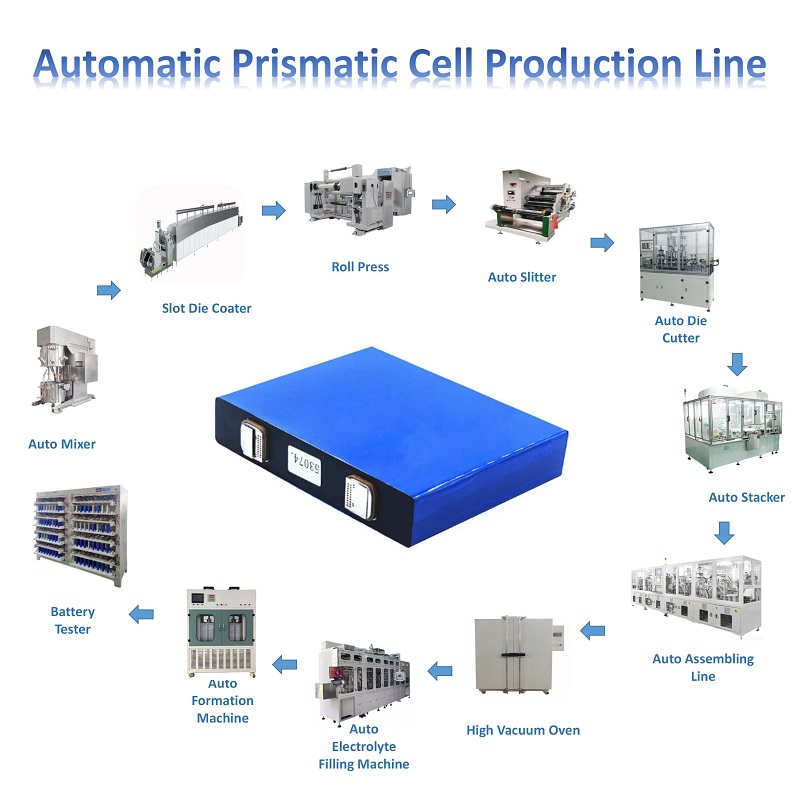Building a Prismatic Cell Manufacturing Plant: A Comprehensive Guide
Establishing a prismatic cell manufacturing plant involves several critical steps, from initial planning and site selection to equipment procurement and quality control. This guide provides an in-depth overview of the essential phases and considerations necessary for building a successful prismatic cell manufacturing facility.
1. Planning and Feasibility Study
Market Analysis
**Demand Forecast: Analyze the market demand for prismatic cells, particularly in sectors such as electric vehicles (EVs), renewable energy storage, and consumer electronics.
**Competitive Landscape: Study the competition, including the production capacities, market shares, and technological advancements of existing manufacturers.
Financial Planning
**Investment Estimation: Calculate the total investment required, covering land acquisition, construction, machinery, and working capital.
**Funding Sources: Identify potential funding sources, such as loans, investors, government grants, or partnerships.
Site Selection
**Location: Choose a strategic location with access to essential infrastructure like transportation, utilities, and skilled labor.
**Infrastructure: Ensure the site has reliable access to electricity, water, gas, and waste disposal facilities.
2. Plant Design and Layout
Design Requirements
**Production Capacity: Determine the desired production capacity based on market demand and scalability considerations.
**Space Planning: Design the layout to optimize workflow efficiency, minimizing material handling and maximizing space utilization.
Layout Planning
**Raw Material Storage: Allocate space for storing raw materials, including electrodes, electrolytes, separators, and casings.
**Production Lines: Designate separate areas for each stage of production: electrode preparation, cell assembly, electrolyte filling, sealing, and formation.
**Quality Control: Establish laboratories and testing areas for quality control and R&D.
**Finished Goods Storage: Plan for storage of finished batteries before shipment.
3. Equipment Procurement
Key Equipment for Prismatic cell fabrication plant
1. **Electrode Preparation Equipment**
**Mixers: Prepare electrode slurry by mixing active materials, binders, and solvents. High-shear mixers ensure uniform consistency.
**Coating Machines: Apply electrode slurry onto current collectors (aluminum for cathode, copper for anode). Precise control over thickness and uniformity is crucial.
**Drying Ovens: Remove solvents from coated electrodes. Continuous or batch ovens can be used based on production scale.
**Calendering Machines: Compress coated electrodes to the desired thickness and density, enhancing electrochemical performance.
**Slitting Machines: Cut the dried and calendered electrodes into precise sizes for further processing.
2. **Cell Assembly Equipment**
**Cutting Machines: Precisely cut separators to match electrode dimensions.
**Stacking Machines: Assemble electrodes and separators into stacks. Automation ensures consistency and precision.
**Tab Welding Machines: Weld current collector tabs to electrodes. Ultrasonic or laser welding is commonly used for strong, reliable connections.
**Electrolyte Filling Machines: Inject electrolyte into assembled cells. Precision filling is essential for optimal cell performance and safety.
**Sealing Machines: Seal the cells using methods like heat sealing, ultrasonic sealing, or laser welding.
3. **Formation and Testing Equipment**
**Formation Equipment: Perform initial charge/discharge cycles to form the solid electrolyte interface (SEI) on the anode and stabilize cell performance.
**Cyclers and Testers: Test cells for capacity, voltage, internal resistance, and other key performance metrics. Automated systems can handle large volumes of cells.
**Environmental Chambers: Simulate various operating conditions (temperature, humidity) to test cell performance and durability.
4. **Safety and Environmental Equipment**
**Fume Hoods and Scrubbers: Control emissions from solvents and chemicals used in electrode preparation and cell assembly.
**Waste Management Systems: Handle and dispose of hazardous waste materials safely and in compliance with regulations.
Vendor Selection
1. **Reputation and Experience**
- Choose vendors with a proven track record in the battery manufacturing industry.
- Check references and case studies of previous installations to ensure reliability and performance.
2. **Technical Support and Training**
- Ensure vendors provide comprehensive training for operating and maintaining equipment.
- Opt for suppliers who offer robust after-sales support, including spare parts availability and technical assistance.
3. **Customization and Flexibility**
- Vendors should be willing to customize equipment to meet specific production requirements.
- Equipment should be adaptable to future changes in battery technology and production processes.
4. **Quality and Certification**
- Ensure equipment meets industry standards and certifications (e.g., CE, ISO).
- Conduct factory acceptance tests (FAT) and site acceptance tests (SAT) to verify equipment performance before final acceptance.
Procurement Process
1. **Specification Development**
- Clearly define equipment specifications based on production needs, including capacity, precision, and compatibility with other systems.
- Consult with technical experts and engineers to ensure all requirements are covered.
2. **Request for Proposal (RFP)**
- Issue RFPs to multiple vendors outlining detailed specifications, project timelines, and budget constraints.
- Evaluate proposals based on technical compliance, cost, delivery time, and vendor reputation.
3. **Evaluation and Selection**
- Create a cross-functional team (engineering, procurement, production) to evaluate proposals.
- Conduct site visits and technical discussions with shortlisted vendors to clarify any doubts and ensure alignment with requirements.
4. **Contract Negotiation**
- Negotiate terms and conditions, including payment schedules, delivery timelines, warranties, and service agreements.
- Ensure clear clauses on performance guarantees, penalties for delays, and responsibilities for installation and commissioning.
5. **Installation and Commissioning**
- Coordinate closely with vendors during the installation phase to ensure proper setup and integration of equipment.
- Perform rigorous testing and calibration to verify equipment performance and compliance with specifications.
- Provide comprehensive training to operators and maintenance staff.
4. Workforce Recruitment and Training
Recruitment
**Skilled Labor: Hire experienced engineers, technicians, and quality control specialists who are knowledgeable about battery manufacturing processes.
**Support Staff: Employ administrative, logistics, and maintenance personnel to support plant operations.
Training Programs
**Technical Training: Provide in-depth training on equipment operation, safety protocols, and quality control procedures.
**Continuous Improvement: Implement ongoing training programs to keep the workforce updated on the latest technologies and best practices in battery manufacturing.
5. Quality Control and Assurance
Quality Management System (QMS)
**Standards Compliance: Establish a QMS that complies with industry standards (e.g., ISO 9001) to ensure consistent product quality.
**Documentation: Maintain thorough documentation of all processes, from raw material inspection to final product testing.
Testing and Inspection
**Raw Material Testing: Conduct rigorous testing of incoming materials to ensure they meet specified quality standards.
**In-Process Inspection: Implement real-time monitoring and inspection at various stages of production to identify and address defects early.
**Final Product Testing: Perform comprehensive testing of finished cells for performance, safety, and durability.
6. Environmental and Safety Considerations
Environmental Management
**Emissions Control: Implement systems to control emissions from solvents and chemicals, ensuring compliance with environmental regulations.
**Waste Management: Develop procedures for the safe disposal and recycling of hazardous waste materials.
Safety Protocols
**Safety Training: Provide regular safety training to all employees, emphasizing the importance of following safety protocols.
**Emergency Response: Establish emergency response plans and conduct regular drills to prepare for potential incidents.
Conclusion
Building a Prismatic cell fabrication line is a complex yet rewarding endeavor that requires meticulous planning, strategic investment, and a commitment to quality and safety. By following this comprehensive guide, businesses can establish a state-of-the-art facility capable of producing high-performance prismatic cells to meet the growing demand for advanced energy storage solutions. With careful execution and continuous improvement, a prismatic cell manufacturing plant can become a cornerstone of innovation and sustainability in the battery industry.

 en
en fr
fr de
de ru
ru es
es pt
pt ko
ko tr
tr pl
pl th
th







 IPv6 network supported
IPv6 network supported